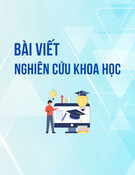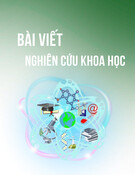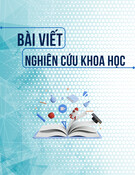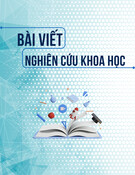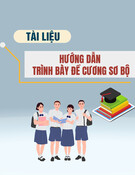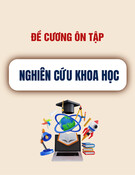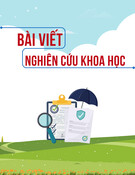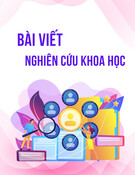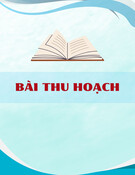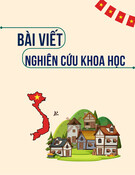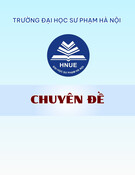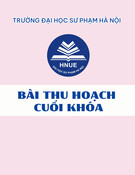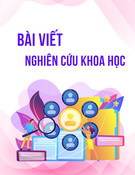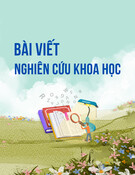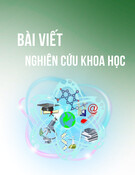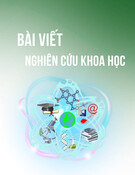
VĂN HÓA https://jst-haui.vn Tạp chí Khoa học và Công nghệ Trường Đại học Công nghiệp Hà Nội Tập 60 - Số 12 (12/2024)
110
NGÔN NG
Ữ
P
-
ISSN 1859
-
3585
E
-
ISSN 2615
-
961
9
STUDENTS’ AND TEACHERS’ PERSPECTIVES ON PROJECT-BASED LEARNING IN A BLENDED-LEARNING TRANSLATION COURSE
QUAN ĐIỂM CỦA SINH VIÊN VÀ GIẢNG VIÊN VỀ PHƯƠNG PHÁP DẠY HỌC DỰ ÁN TRONG KHÓA HỌC BIÊN DỊCH KẾT HỢP Nguyen Thi Minh Hanh1,*, Cao Thi Hai Hang1, Bui Thi Thu Giang1, Nguyen Thi Thuy Trang2, Lai Thi Thanh Van3 DOI: http://doi.org/10.57001/huih5804.2024.425 ABSTRACT This research was conducted at a public university in Vietnam where project-based learning (PBL) has been integrated into various
courses. Notably, this marks
only the second instance of PBL being used in a blended learning format, an area that remains underexplored. The study seeks
to examine both students’ and teachers’
perceptions of the effects of PBL, specifically through the implementation of a Magazine Project within a blended translation course. A mixed-
methods approach was
utilized, gathering data from 107 third-year English majors via an online questionnaire, in-depth interviews with eight students, alongside semi-structured
interviews
with five course instructors. Findings indicated positive responses from both students and teachers regarding learner autonomy, problem-
solving abilities,
collaboration, and IT skills. However, the study also highlighted challenges such as a la
ck of individualized support and the use of ineffective learning tools. The paper
concludes with practical recommendations for optimizing PBL in blended learning contexts, targeting educators and researchers. Keywords: Blended learning; language education; perspectives; project-based learning; translation. TÓM TẮT Nghiên cứu được thực hiện tại một trường đại học công lập ở Việt Nam, nơi phương pháp dạy học dự án đã được áp dụng trong nhiều khóa họ
c. Tuy nhiên,
đây mới là lần thứ hai phương pháp này được triển khai trong môi trường học kết hợp và chưa có nghiên cứu nào được thực hiện nhằm kiểm chứng tác động củ
a
việc áp dụng phương pháp này lên hiệu quả học tập. Mục tiêu của nghiên cứu là làm sáng tỏ góc nhìn của sinh viên và giảng viên về tác động của
phương pháp
học dự án dưới hình thức Dự án Tạp chí trong một khóa học dịch thuật kết hợp giảng dạy trực tiếp và trực tuyến. Phương pháp nghiên cứu hỗn hợp đã được s
ử
dụng để thu thập dữ liệu từ 107 sinh viên năm ba chuyên ngành tiếng Anh thông qua bảng câu hỏi khảo sát trực tuyến, phỏng vấn sâu với tám sinh viên
và các
cuộc phỏng vấn bán cấu trúc cá nhân với năm giảng viên chuyên ngành. Kết quả cho thấy, phản hồi tích cực từ sinh viên và giảng viên về tính tự chủ, kỹ
năng
giải quyết vấn đề, khả năng làm việc nhóm và kỹ năng công nghệ thông tin của người học. Tuy nhiên, cũng có những vấn đề được nêu ra như việc hỗ trợ
cá nhân
chưa đủ và công cụ học tập không hiệu quả trong quá trình triển khai dự án học kết hợp. Cuối cùng, nghiên cứu đã đưa ra các khuyến nghị giáo dục liên quan đế
n
việc triển khai hiệu quả của phương pháp học dự án trong môi trường học tập kết hợp dành cho các nhà giáo dục và nhà nghiên cứu. Từ khóa: Học kết hợp; giảng dạy ngoại ngữ; quan điểm; phương pháp dạy học dự án; dịch thuật. 1School of Languages and Tourism, Hanoi University of Industry, Vietnam 2Faculty of Foreign Languages, Academy of Finance, Vietnam 3Chisholm Institute, Melbourne, Australia *Email: nguyenthiminhhanh@haui.edu.vn Received: 07/9/2024 Revised: 29/10/2024 Accepted: 26/12/2024 1. INTRODUCTION Project-based learning (PBL) has become an increasingly popular pedagogical approach, particularly in language and translation studies, as it offers students the opportunity to engage in real-world tasks that enhance their practical skills and deepen their understanding of





